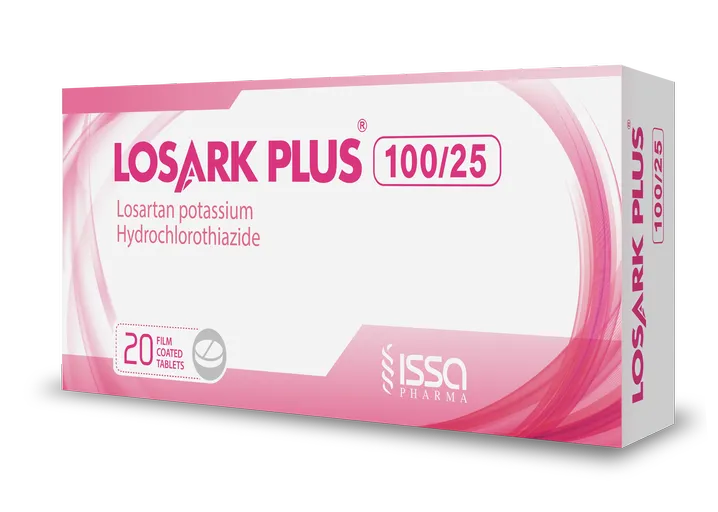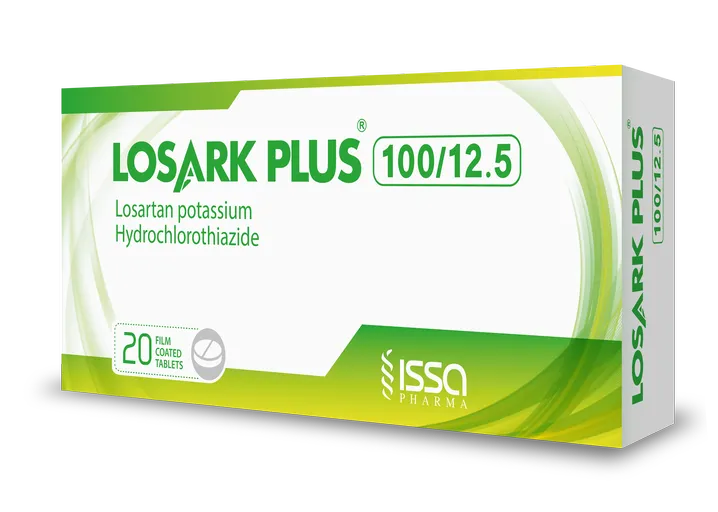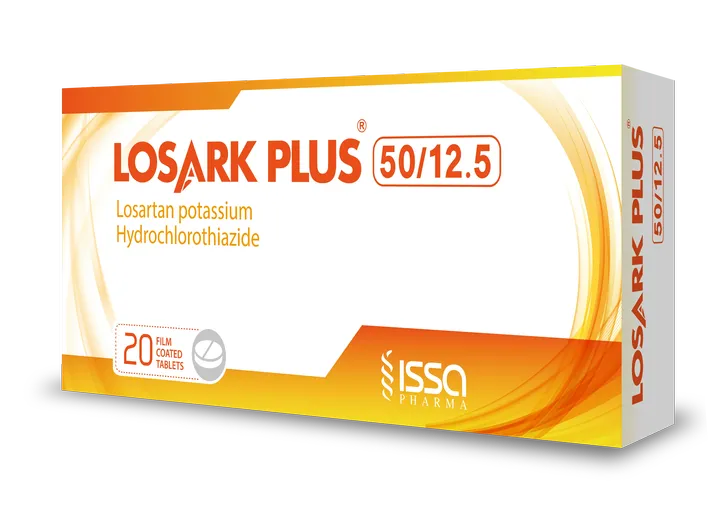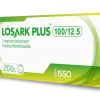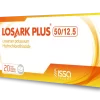COMPOSITION AND EXCIPIENTS
Active Ingredients:
- Each film coated tablet of Losark Plus 50 / 12.5 contains 50 mg Losartan potassium and 12.5 mg hydrochlorothiazide.
- Each film coated tablet of Losark Plus 100 / 12.5 contains 100 mg Losartan potassium and 12.5 mg hydrochlorothiazide.
- Each film coated tablet of Losark Plus 100 / 25 contains 100 mg Losartan potassium and 25 mg hydrochlorothiazide.
Excipients:
Microcrystalline cellulose, Lactose monohydrate, Pregelatinized maize starch, Magnesium Stearate, Hyprolose, Hypromellose, Titanium dioxide, Yellow iron oxide (For 50/12.5),Green colorant E142 (For 100/12.5), Red colorant E124 (For 100/25)
MECHANISM OF ACTION
Losartan Potassium: Losartan and its principal active metabolite block the vasoconstrictor and aldosterone-secreting effects of angiotensin II by selectively blocking the binding of angiotensin II to the AT1 receptor found in many tissues (e.g., vascular smooth muscle, adrenal gland).
Hydrochlorothiazide: Hydrochlorothiazide is a thiazide diuretic.
PHARMACODYNAMICS
Losartan Potassium: A dose of 100 mg inhibits the pressor effect of angiotensin II by about 85% at peak with 25-40% inhibition persisting for 24 hours. The effect of losartan is substantially present within one week but in some studies the maximal effect occurred in 3-6 weeks.
Hydrochlorothiazide: After oral administration of hydrochlorothiazide, diuresis begins within 2 hours, peaks in about 4 hours, and lasts about 6 to 12 hours.
PHARMACOKINETICS
Losartan Potassium:
Absorption: Following oral administration, losartan is well absorbed and undergoes substantial first-pass metabolism by cytochrome P450 enzymes. The systemic bioavailability is approximately 33%. Mean peak concentrations of losartan and its active metabolite are reached in 1 hour and in 3-4 hours, respectively. Meals slow absorption of losartan.
Distribution: Both losartan and its active metabolite are highly bound to plasma proteins, primarily albumin.
Elimination: The terminal half-life of losartan is about 2 hours and of the metabolite is about 6-9 hours. After single doses of losartan administered orally, about 4% of the dose is excreted unchanged in the urine and about 6% is excreted in urine as active metabolite. Biliary excretion contributes to the elimination of losartan and its metabolites. Neither losartan nor its metabolite accumulates in plasma upon repeated once-daily dosing.
Hydrochlorothiazide:
Hydrochlorothiazide is not metabolized but is eliminated rapidly by the kidney. The plasma half-life varies between 5.6 and 14.8 hours. At least 61% of the oral dose is eliminated unchanged within 24 hours.
INDICATIONS
- Hypertension.
- Hypertensive Patients with Left Ventricular Hypertrophy: it is indicated to reduce the risk of stroke in patients with hypertension and left ventricular hypertrophy.
CONTRAINDICATIONS
- In patients who are hypersensitive to any component of this product.
- In patients with anuria.
- Co-administration with aliskiren in patients with diabetes.
WARNINGS AND PRECAUTIONS
Fetal Toxicity: Use of drugs that act on the renin-angiotensin system during the second and third trimesters of pregnancy reduces fetal renal function and increases fetal and neonatal morbidity and death. Resulting oligohydramnios can be associated with fetal lung hypoplasia and skeletal deformations. Potential neonatal adverse effects include skull hypoplasia, anuria, hypotension, renal failure, and death. When pregnancy is detected, discontinue losartan as soon as possible.
Thiazides cross the placental barrier and appear in cord blood. There is a risk of fetal or neonatal jaundice, thrombocytopenia, and possibly other adverse reactions that have occurred in adults.
Hypotension in Volume- or Salt-Depleted Patients: In patients with an activated renin-angiotensin system, such as volume- or salt-depleted patients (e.g., those being treated with high doses of diuretics), symptomatic hypotension may occur after initiation of treatment. Volume or salt depletion should be corrected prior to administration of the drug. This drug should not be used as initial therapy in patients with intravascular volume depletion.
Impaired Renal Function: Changes in renal function including acute renal failure can be caused by drugs that inhibit the renin-angiotensin system and by diuretics. Patients whose renal function may depend in part on the activity of the renin-angiotensin system (e.g., patients with renal artery stenosis, chronic kidney disease, severe congestive heart failure, or volume depletion) may be at particular risk of developing acute renal failure on the drug. Monitor renal function periodically in these patients. Consider withholding or discontinuing therapy in patients who develop a clinically significant decrease in renal function on the drug.
Hypersensitivity: Hypersensitivity reactions to hydrochlorothiazide may occur in patients with or without a history of allergy or bronchial asthma, but are more likely in patients with such a history.
Electrolyte and Metabolic Effects: the drug contains hydrochlorothiazide which can cause hypokalemia, hyponatremia and hypomagnesemia. Hypomagnesemia can result in hypokalemia which may be difficult to treat despite potassium repletion. This drug also contains losartan which can cause hyperkalemia. Therefore, Monitoring of serum electrolytes periodically should be done.
Hydrochlorothiazide may alter glucose tolerance and raise serum levels of cholesterol and triglycerides.
Hyperuricemia may occur or frank gout may be precipitated in patients receiving thiazide therapy. Because losartan decreases uric acid, losartan in combination with hydrochlorothiazide attenuates the diuretic-induced hyperuricemia.
Hydrochlorothiazide decreases urinary calcium excretion and may cause elevations of serum calcium. Therefore, Monitoring of calcium levels should be done.
Acute Myopia and Secondary Angle-Closure Glaucoma: Hydrochlorothiazide, a sulfonamide, can cause an idiosyncratic reaction, resulting in acute transient myopia and acute angle-closure glaucoma. Untreated acute angle-closure glaucoma can lead to permanent vision loss. The primary treatment is to discontinue hydrochlorothiazide as rapidly as possible. Prompt medical or surgical treatments may need to be considered if the intraocular pressure remains uncontrolled. Risk factors for developing acute angle-closure glaucoma may include a history of sulfonamide or penicillin allergy.
Systemic Lupus Erythematosus: Thiazide diuretics have been reported to cause exacerbation or activation of systemic lupus erythematosus.
Post-sympathectomy Patients: The antihypertensive effects of the drug may be enhanced in the post-sympathectomy patient.
Pregnancy, Category D:
When pregnancy is detected, discontinue the drug as soon as possible.
In the unusual case that there is no appropriate alternative to therapy with drugs affecting the renin-angiotensin system for a particular patient, the mother should be apprised of the potential risk to the fetus. Perform serial ultrasound examinations to assess the intra-amniotic environment. If oligohydramnios is observed, the drug should be discontinued, unless it is considered lifesaving for the mother. Fetal testing may be appropriate, based on the week of pregnancy. Patients and physicians should be aware, that oligohydramnios may not appear until after the fetus has sustained irreversible injury.
Nursing Mothers:
It is not known whether losartan is excreted in human milk. Thiazides appear in human milk. Because of the potential for adverse effects on the nursing infant, a decision should be made whether to discontinue nursing or discontinue the drug, taking into account the importance of the drug to the mother.
Pediatric Use:
Safety and effectiveness of the drug in pediatric patients have not been established.
Geriatric Use:
No overall differences in effectiveness were observed between these patients and younger patients. Adverse events were somewhat more frequent in the elderly compared to non-elderly patients.
Hepatic Impairment:
Initiation of the drug is not recommended for patients with hepatic impairment because the appropriate starting dose of losartan, 25 mg, is not available.
Renal Impairment:
Changes in renal function have been reported in susceptible individual. Safety and effectiveness of the drug in patients with severe renal impairment (creatine clearance <30 mL/min) have not been established.
DRUG INTERACTIONS
Agents Increasing Serum Potassium: Coadministration of losartan with other drugs that raise serum potassium levels may result in hyperkalemia.
Lithium: Increases in serum lithium concentrations and lithium toxicity have been reported with concomitant use of angiotensin II receptor antagonists or thiazide diuretics.
Non-Steroidal Anti-Inflammatory Agents:
- Losartan Potassium: In patients who are elderly, volume-depleted (including those on diuretic therapy), or with compromised renal function, coadministration of NSAIDs, including selective COX-2 inhibitors, with angiotensin II receptor antagonists (including losartan) may result in deterioration of renal function, including possible acute renal failure. These effects are usually reversible. Periodic Monitoring of the renal function in these patients should be done.
- Hydrochlorothiazide: The administration of NSAIDs can reduce the diuretic, natriuretic, and antihypertensive effects of loop, potassium-sparing and thiazide diuretics. In patients receiving diuretic therapy, coadministration of NSAIDs with angiotensin receptor blockers, including losartan, may result in deterioration of renal function, including possible acute renal failure. These effects are usually reversible. Periodic Monitoring of the renal function in these patients should be done.
Dual Blockade of the Renin-Angiotensin System (RAS): Dual blockade of the RAS with angiotensin receptor blockers, ACE inhibitors, or aliskiren is associated with increased risks of hypotension, syncope, hyperkalemia, and changes in renal function (including acute renal failure) compared to monotherapy. Aliskiren use should be avoided with this drug in patients with renal impairment (GFR <60 mL/min).
The Use of Hydrochlorothiazide with Other Drugs:
- Anti-diabetic drugs: dosage adjustment of the antidiabetic drug may be required.
- Cholestyramine and colestipol resins: Absorption of hydrochlorothiazide is impaired in the presence of anionic exchange resins; therefor it should be administered at least 4 hours before or after the administration of the resin.
ADVERSE REACTIONS
Most adverse reactions have been mild and transient in nature and have not required discontinuation of therapy. Adverse reactions occurring in greater than 2% of subjects treated with losartan-hydrochlorothiazide and at a greater rate than placebo were: back pain, dizziness, and upper respiratory infection.
The following additional adverse reactions have been reported in clinical trials with this drug and/or the individual components: Anemia, aplastic anemia, hemolytic anemia, leukopenia, agranulocytosis, Anorexia, hyperglycemia, hyperuricemia, electrolyte imbalance including hyponatremia and hypokalemia, Insomnia, restlessness, Dysgeusia, headache, migraine, paraesthesias, Xanthopsia, transient blurred vision, Palpitation, tachycardia, Dose-related orthostatic effects, necrotizing angiitis (vasculitis, cutaneous vasculitis), Nasal congestion, pharyngitis, sinus disorder, respiratory distress (including pneumonitis and pulmonary edema), Dyspepsia, abdominal pain, gastric irritation, cramping, diarrhea, constipation, nausea, vomiting, pancreatitis, sialoadenitis, Jaundice (intrahepatic cholestatic jaundice), Rash, pruritus, purpura, toxic epidermal necrolysis, urticaria, photosensitivity, cutaneous lupus erythematosus, Muscle cramps, muscle spasm, myalgia, arthralgia, Glycosuria, renal dysfunction, interstitial nephritis, renal failure, Erectile dysfunction/impotence, Chest pain, edema/swelling, malaise, fever, weakness, Liver function abnormalities, Cough.
DOSAGE AND ADMINISTRATION
Hypertension: The usual starting dose of the drug is 50/12.5 once daily. The dosage can be increased after 3 weeks of therapy to a maximum of 100/25 once daily as needed to control blood pressure.
Initiate a patient whose blood pressure is not adequately controlled with losartan 50 mg monotherapy with 50/12.5 of this drug once daily. If blood pressure remains uncontrolled after about 3 weeks of therapy, the dosage may be increased to two tablets of the drug 50/12.5 once daily or one tablet of the drug 100/25 once daily.
Initiate a patient whose blood pressure is not adequately controlled with losartan 100 mg monotherapy with the drug 100/12.5 once daily. If blood pressure remains uncontrolled after about 3 weeks of therapy, increase the dose to two tablets of the drug 50/12.5 once daily or one tablet of the drug 100/25 once daily.
Initiate a patient whose blood pressure is inadequately controlled with hydrochlorothiazide 25 mg once daily, or is controlled but who experiences hypokalemia with this regimen, on the drug 50/12.5 once daily, reducing the dose of hydrochlorothiazide without reducing the overall expected antihypertensive response. Evaluate the clinical response to the drug 50/12.5 and, if blood pressure remains uncontrolled after about 3 weeks of therapy, increase the dose to two tablets of the drug 50/12.5 once daily or one tablet of the drug 100/25 once daily.
Hypertensive Patients with Left Ventricular Hypertrophy: In patients whose blood pressure is not adequately controlled on 50 mg losartan potassium, initiate treatment with the drug 50/12.5. If additional blood pressure reduction is needed, increase the dose to the drug 100/12.5, followed by the drug 100/25. For further blood pressure reduction add other antihypertensives.
OVERDOSAGE
Losartan Potassium: Limited data are available in regard to overdosage in humans. The most likely manifestation of overdosage would be hypotension and tachycardia; bradycardia could occur from parasympathetic (vagal) stimulation. If symptomatic hypotension should occur, supportive treatment should be instituted. Neither losartan nor its active metabolite can be removed by hemodialysis.
Hydrochlorothiazide: The most common signs and symptoms observed are those caused by electrolyte depletion (hypokalemia, hypochloremia, hyponatremia) and dehydration resulting from excessive diuresis. If digitalis has also been administered, hypokalemia may accentuate cardiac arrhythmias.
STORAGE CONDITIONS
Store at temperature below 25° C, away from light and moisture.
PACKAGING
Losark Plus is available in blister strips (Aluminum – Transparent P.V.C), each strip contains 10 film coated tablets and each pack contains 1 , 2 or 3 strips with enclosed leaflet (10 , 20 or 30 film coated tablets per pack).

